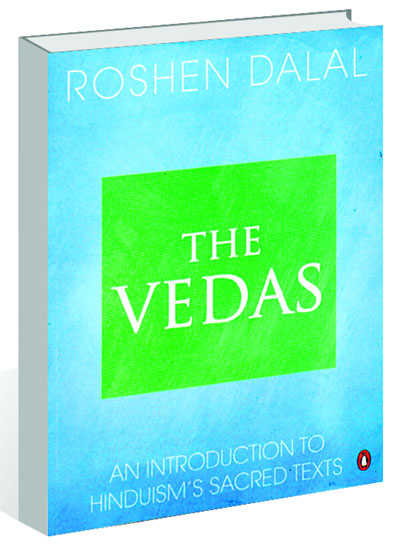
The Vedas: An Introduction to Hinduism's Sacred Texts by Roshen Dalal. Penguin. Pages 410. Rs 699
Kuldip Singh Dhir
The Vedas are the fountainhead of our religious, cultural and literary heritage. Roshen Dalal sifts through centuries of information and research to provide an authoritative and comprehensive account of the Vedas that appeal both to scholars and readers. The four samhitas — Rig, Sama, Yajur and Atharva are considered Shrutis, which means that these were texts meant for rishis. Each Veda was studied by a shakha or group of rishis and each shakha was different from the other.
Patanjali’s Mahabhashya refers to 21 shakhas of the Rig Veda and 101 of the Yajur Veda. We are told that Rishi Vyasa arranged the samhitas in their present form. Over 400 rishis are associated with the Rig. Twenty one of these are rishikas (women). The Rig has 1,018 hymns and 10,552 verses divided into 10 mandals. The Yajur has 1,975 hymns in one version and 2,086 in the other. Most of the verses in the Sama are a rearrangement of those in the Rig on the basis of music. The Atharva has 731 verses. The author has reproduced first hymn followed by a sectionwise gist of the content of all four Vedas.
Dalal explains that each Veda has its Brahamanas for the guidance of priests. These contain rules, explanations and legends to elucidate the content in the Vedas. The complexity of these texts gradually resulted in supremacy of a priestly class called Brahmana. The Brahmanas are followed by the Aranyakas and the Upanishads. These focus on asceticism, knowledge and enquiry. Philosophical concepts, mystical symbolism and attainment of the absolute are their primary concerns.
Philosophical concepts of the Upanishads further branch into six orthodox schools of Hindu philosophy, a brief account of which has been given by the author. She justifies the emergence of another group of texts — the Vedangas as an aid to understand the esoteric form and content of the Vedas. These deal with phonetics, pronunciation, grammar, metre and etymology. The nature, scope and important texts have been suitably covered in this tome.
The Rig refers to various theories of creation such as the separation of heaven and Earth, creation from sacrifice, creation from the golden egg Hiranyagarbha through unknown god (aka) Prajapati and ends with pondering over creation with an element of philosophical inquiry. This has striking similarities and also fundamental differences with Guru Nanak’s formulations on the issue.
The Rig has no clear concept of supreme creator. Indra, Varuna and Prajapati are all supreme in different verses. Dalal considers the Sama Veda as the musical-song book and the Yajur, a prayer book for all practical purposes. The Atharva has the concept of a Supreme God identified with Prajapati and also of a creative principle.
Rituals were believed to provide occult connections with the divine. At several places, symbolic nature of the sacrifice is indicated. A cooking pot represents the sky or the Earth for that matter. Terminology, priests, materials, rituals and methods concerning various types of sacrifices, including Ashvamedha, Purushamedha and Rajasuya have been explained as well.
Dalal has written about different interpretations of the Vedas over the centuries. Sayana’s commentary focuses mostly on the material and ritualistic aspects. Western scholars have used insights from Sayana and Brahmanas, developing these in the light of modern theories and the comparative method.
Dayanand’s interpretation is governed by his conviction that the Vedas are a plenary revelation of all religious, ethical and scientific truth. The teaching is monotheistic, which means that Vedic gods are just different names of one deity, a formulation which has reverberations in the Sikh scripture as well.
Aurobindo interprets the Vedas at two levels. The outer level confines to rituals and ceremonies for the common man. He asserts that there are mysteries and hidden meanings at the inner level. She underlines the fact that in the later years of his life, Aurobindo postulated that divine truth is greater than any scripture, including the Vedas.
This treatise steers a path through innumerable theories to arrive at some pointers on their possible date, origin and the people who composed the Vedic literature. She opines that the assertion that the Vedas were composed at the time of creation of universe can be understood only as a metaphor for the eternal word.
Historically, these were texts in which hymns were carefully put together and arranged by Vyasa. The two groups of people who gave birth to these seemed to live in contiguity. This common region lay between Afghanistan and Yamuna. Dalal dates the Rig between 4,000 BC and 1,000 BC and concludes that it was composed in north-western India that is the undivided Punjab. Later, the Vedic literature was composed subsequently in a region moving further towards the East.
A classified index of the hymns in the Rig, along with their deities and the composer rishis, is available in this work. To give us a feel and fragrance of the texts, Dalal has appended English translations of important hymns from the four samhitas. This scholarly work can serve as a valuable companion to the study of the Vedas and the Vedic literature.



























